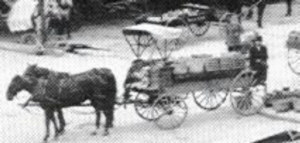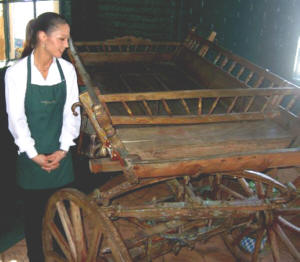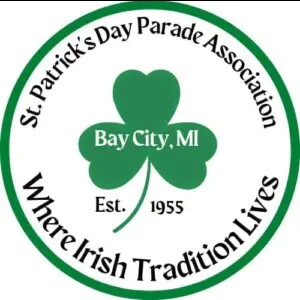Hucksters Clip-Clopped Across Bay City in the Depression Years & Earlier
|
||||||||||||||
| Printer Friendly Story View |

Fruit peddler's wagon is loaded and ready to leave the old Bay County Market on Washington in the 1890s.

Megan Tacey, server at the Atrium Restaurant, looks over a 19th century Gypsy cart from Europe recently acquired by Bill and Elaine Fournier.
(EDITOR'S NOTE: The addition of a 19th century Gypsy peddler's cart from Europe to the antique decor of the Atrium Restaurant, Water and Third, recalls two forgotten periods in Bay City history when such carts were seen on local streets: the era of the Jewish peddlers, 1890-1915, and the Depression era of the hucksters, 1930 until World War II.
Early in the morning in the 1930s and early 1940s in Bay City, the factory whistles would sound all over town.
And in the late summer and fall, when the elms and oaks and maples were exploding with colors that later would be fashionably named fushia and ochre, you would hear them coming far down the street.
Suddenly, as you sat on the windowsill in your second story bedroom that seemed far above the Fifth Avenue, you would hear the clip-clop, clip-clop, steadily growing louder.
"Apple apple, we have nice strawberries today. Cherries, cucumbers, nice ripe melons . . . Apple apple."
The call of the peddler with his horse-drawn cart rings across the decades, still reverberating even today and out of season.
Other sounds were heard: "Toot toot, whoooo," the factory whistles from Defoe, I-B, Shovels, AutoLite, Lewis Manufacturing and others calling for workers to feed the fires that fumed their smokestacks.
The whistles were loud and raucous, but sweet sounds to those Bay Cityans lucky enough to answer them. The unemployment rate during the Depression was about 20 percent, so many breadwinners had to turn to other means of making a living -- like being a huckster.
"Apple apple," the huckster's siren was nearer now, sounding like he was just outside the house.
Housewives and daughters slipped out of back doors with baskets to fill, and men would stop on the way to shop or office and grab some fruit for fellow workers.
The breeze gently rustled the shimmering leaves, splashing color across the sidewalks.
The dappled color blobs moved slowly across verdant lawns and up the clapboard sides of the houses.
Soon sleepy eyed children began to emerge to answer the huckster's call. "Apple apple." They moved as if in a trance, mesmerized by the pied piper, clutching coins for the purchase.
"Here you go, young fella," the huckster said, handing down a bag of shiny Macintoshes for maybe a nickle or a dime.
Other hucksters would come along, the "rag man," seeking donations for who knows what, the "tin man" with pots and pans for sale, the "scrap man," collecting metal on his way to Hirschfield's.
They all had a horse and a cart and an occupation of sorts. They were a phenomenon of the Depression that lasted into the war years. They were known as hucksters, and listed as such in the city directory.
The term huckster later became confused with other, mostly nefarious, callings such as con man, cheats and scam artists, phone hucksters, Internet hucksters, lawn hucksters selling green grass elixirs, even religious hucksters. The term is perhaps best known as a radio or television advertising writer, as depicted in the 1947 Clark Gable-Deborah Kerr film, "The Hucksters."
But we had real hucksters here in Bay City, and they weren't bad people, they were just trying to make a living any way they could.
In 1942, there were nearly a dozen hucksters in Bay City, Sam Badalementi, 703Third; William Donnelly, 310 E. Linn; Ralph Fulco, 1110 N. Monroe; John Klosowski, 507 S. Sherman; two Lupos, Sam and Matt on North Jackson, John Thybault Jr., 105 Fitzgerald, down in the "Frenchtown" area near the river my grandfather called "Pinchgut."And others, all with their own daily aims. Horse-drawn carts fanning out across the tree-lined streets, men in search of a calling, an income, a way of life.
Before the Depression no hucksters were listed in the Bay City directory. And by 1948 they had disappeared.
Johnny Thybault of Pinchgut must have lost his horse because after the war he was a familiar sight walking on streets and highways, the tails of his black coat flapping in the wind. "There's Johnny!" passersby would exclaim, a far cry from the "Here's Johnny!" known to television viewers later. It was rumored he had a home in an underground cave near Linwood and that he had squirreled away a lot of money. The rumor was never confirmed.
Many generations earlier Bay City had a tradition of Jewish immigrant peddlers, recalled Lillian R. Greenstein in an article in the Michigan Jewish History journal in the 1980s.
(We are indebted to former downtown Bay City "maven" Donald Allen Sherman who sent us this article some 20 years ago.)
Replacing the New England Yankee peddlers who had turned to storekeeping were an estimated 250,000 Jewish men who became peddlers between 1850 and 1920, writer Harry Golden recounted in a 1963 book, "Forgotten Pioneer." Most were destitute eastern European immigants who turned to peddling and collecting scrap with horse and wagon to earn a living.
Dr. Greenstein, an occupational therapist and writer on Jewish history, grew up in theBay City peddler community. She earned a master's degree in education from the University of Michigan, Ann Arbor, and a doctoral degree in educational psychology from the University of Alabama, Montgomery, AL. She recalled that Bay City was a gateway to northern Michigan and the Thumb where Jewish peddlers brought household materials to rural areas in exchange for scrap "junk."
Besides recounting her own girlhood experiences, Dr. Greenstein interviewed Bessie Diamond Jaffe and Howard Kraska in 1983 for the article.
The 1893-94 city directory listed 17 peddlers and by the 1900 census some 25 identifiable Jewish names were listed as peddlers, according to Dr. Greenstein.
Two congregations served the thriving Jewish community along 12th Street (Columbus), the reform church, Anshe Chesed, and the orthodox, Schari Zadeck.
Herman Hirschfield was said to have been the "guardian angel" of the Jewish peddlers. He purchased and processed salvage from the peddlers, kept their accounts and even advanced payments when the need arose. "He helped a number of immigrant families to survive," wrote Dr. Greenstein.
Thirty Jewish peddlers were identified in the 1915 Bay City directory. The American Jewish Yearbook included Bay City among communities with 1,000 Jews in 1917-18, but numbers began to decline after that.
Bay City Jewish peddlers listed in the 1900 U.S. Census, addresses and countries of origin, were: Abramson, Julius, 314 S. Lincoln, Germany; Beckman, Joseph, 518 S. Farragut, Russia; Biller, Jake, 300 S. Lincoln, Germany; Biller, Robert, 220 S. Sherman, Germany; Fairberg, Meyer, 906 S. VanBuren, Russia; Goldberg, L., 1300 Columbus, Russia; Golden, Max, 513 S. Farragut, Russia; Goldman, Abraham, 300 S. Farragut, Germany; Grabowsky, George, 205 Monroe; Greenberg, Samuel, 512 S. Sheridan, Russia; Kaufman, Hyman, 501 S. Farragut, Russia; Kintz, Abraham, 314 S. Sherman, Germany; Jeffe, C., 302 S. Lincoln, Germany; Livingston, M., 106 S. Farragut, Russia; Mandel, I, 420 S. Farragut, Russia; Mangold, Herman, 308 S. Farragut, Germany; Marienthal, Aaron, 1300 Columbus, Germany; Mendell, Joseph, 112 N. Farragut, Germany; Miller, Thomas, 207 Monroe, Russia; Newman, Louis, 107 N. Farragut; Rausoff, Max, 310 S. Farragut, Germany; Rosenburg, Isaac, 312 S. Sheridan, Germany; Sonnenstrahl, S., 318 S. Farragut, Germany; Vahloff, Sam, 209 S. Sherman, Germany.
Other familiar Bay City names listed in later city directories included David Diamond, 208 N. Sheridan; Daniel Feldman, 1304 14th; Aaron Fagan, 920 Columbus; Charles Gordon, 208 Washington; David Green, 215 N. Lincoln; Ben Greenstein, 212 S. Sherman; Isaac Greenstein, 316 S. Farragut; Harry Immerman, 211 N. Grant; Benjamin Levin, 906 13th; Louis Levy, 200 S. Sheridan; Louis and Morris Magidson, 1104 11th; Barney Pearlman, 1013 11th; Harry Surath, 221 S. Lincoln, and Samuel Werbelow, 209 S. Sherman.###
| Printer Friendly Story View |

|
Prior Article
March 5, 2025 by: Stephen Kent St. Patricks Parade 2025 - IT's TIME |

|
Next Article
February 10, 2020 by: Rachel Reh Family Winter Fun Fest is BACC Hot Spot for 2/10/2020 |
|
|

Dave Rogers |
|
|
|
Printer-Friendly Story View
0200 Nd: 04-28-2025 d 4 cpr 0
12/31/2020 P3v3-0200-Ad.cfm
SPONSORED LINKS
12/31/2020 drop ads P3v3-0200-Ad.cfm
